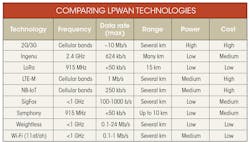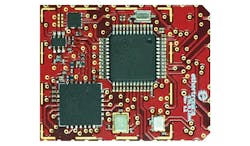Download this article in PDF format.
Most engineers consider the Internet of Things (IoT) as a collection of short-range wireless technologies that connect devices to the internet for some useful purpose. And most current IoT applications seem to fall into that category. However, that mindset is changing.
Many wireless standards are limited by their range, which is problematic for a number of useful applications that require much longer paths. To overcome that hurdle, a collection of newer longer-range wireless technologies have emerged. Called low-power wide-area networks (LPWANs), these links fill the gap between traditional short-range technologies and the more costly M2M alternatives (see table).
What is Long Range?
There’s no formal definition for long range, but today’s most popular technologies have essentially set its parameters in place. One prominent maximum range is 10-30 meters. Bluetooth, ZigBee, and 802.15.4-based technologies use this figure as a guideline, but longer ranges are also possible under favorable conditions. Wi-Fi is said to have a maximum usable range of 100 meters, but it’s typically less than that. Even shorter ranges from standards like IrDA, NFC, and RFID max out at a foot or so.
All of these standards are useful, as evidenced by the IoT successes so far. Nonetheless, some industrial and public utility applications simply need more range to be viable.
For this article, I define long range as anything greater than a few hundred meters up to 30 to 50 miles. LPWAN vendor LinkLabs defines long range as up to 10 km. Applications requiring such range involve the monitoring and/or control of some equipment or system. Examples include the smart grid and utility water or gas metering. Other longer-range uses include city lighting control and agriculture monitoring. Most of the available short-range technologies cannot reliably deliver the ranges necessary for these applications.
Achieving Longer Range
The range of a radio signal is determined by a number of factors: frequency of operation, transmitter power, antenna gains, receiver sensitivity, antenna height, physical obstructions (e.g., buildings and trees), data rate, and noise and interference. While all are important, perhaps the one that carries the most weight is frequency. The basic physics of wireless says that lower frequencies travel farther than higher frequencies. Path distance is directly proportional to wavelength (λ), where wavelength is:
λ = 300/fMHz
As the frequency shrinks, the range lengthens. That holds true for signals with line-of-sight (LOS) propagation. LOS infers that the transmitting antenna can “see” the receiving antenna. Signals above about 50 MHz have this characteristic, but it’s more pronounced at UHF, microwave, and millimeter-wave frequencies.
Frequencies below 1 GHz do exhibit some non-LOS characteristics (meaning they can penetrate walls and trees to a degree), making them desirable when direct LOS isn’t possible. That’s one reason why cellular frequencies in the 800- to 1000-MHz range are so coveted. And that’s why much of the newly reassigned 600- and 700-MHz bands are being sold to cellular operators.
You can also see this range vs. frequency phenomenon by looking at the radio path-loss equation.
dB path loss = 37 dB + 20log(f) + 20log(d)
Distance (d) is in miles and frequency (f) is in MHz.
Now consider the location of the most popular IoT technologies. Yep, the unlicensed 2.4-GHz band. Newer Wi-Fi versions like 11ac and 11ax use 5 GHz. Wi-Fi, Bluetooth, ZigBee, and 802.15.4 derivatives like Thread, ISA100a, and others use the 2.4 GHz unlicensed band. The power level is also restricted—no wonder range is limited. In some applications, mesh networking can help extend range, but that’s for special cases that require many nodes.
Other key factors influencing range are data rate and noise. Higher speeds tend to limit range, with noise playing a major role in the bit error rate (BER). Lower data rates consume less bandwidth, and a smaller bandwidth limits the noise, creating a more reliable connection. Using higher levels of modulation (e.g. QAM) boosts speed. However, it’s more susceptible to noise, making the link less robust. Range automatically goes up as data rate drops, since it’s generally more immune to noise.
Most LPWAN technologies work with a total path loss in the 130- to 180-db range, far greater than the typical path loss in the 90-db range of traditional wireless technologies. This requires a receiver sensitivity of ‒130 dBm or better for a good connection. Such sensitivity levels are possible with the narrower bandwidths and lower data rates of LPWAN products.
While longer range is the key feature of LPWANs, lower data rate and low power consumption are also core features. How low is low data rate? One definition says that it’s less than 5 kb/s with fewer than 200 bytes per message. It can be as low as several hundred bits per second or as high as 100 kb/s. Even higher rates are possible at reduced range.
Another important factor is very low power consumption. Most applications assume battery-powered nodes in this context. To make the LPWAN viable, battery life is crucial—it must be years, even five to 10 years by some standards.
Most of the newer long-range technologies take these qualities into account and can deliver the extended links required by many applications. In no particular order, let’s take a look at what’s available:
ISM Band
Most of the standards discussed here utilize the unlicensed industrial-scientific-medical (ISM) bands set aside by the FCC in Part 15 of the Code of Federal Regulations (CFR) 47. The most widely used ISM band is the 2.4 - to 2.483-GHz band, which is the province of Wi-Fi, Bluetooth, 802.15.4 radios, and many others. The 902-928 MHz band is the next most-used, with 915 MHz being a sweet spot. Other popular ISM frequencies are 315 MHz for garage-door openers and remote-keyless-entry (RKE) applications and 433 MHz for remote temperature monitoring. In the UK and Europe, 169 MHz and 868 MHz are popular.
1. Microsemi’s ZL70550 transceiver IC, targeted at ISM band LPWAN applications, comes in a 32-pin QFN package measuring 5 × 5 mm.
Many simple wireless applications don’t require complex network connections, security, or other custom features, which makes it possible to design simple proprietary protocols. Many vendors of ISM-band transceivers offer standard protocol support and development systems that can be used to develop a protocol for a specific application.
For example, Microsemi developed the ZL70550 ISM band transceiver (Fig. 1) for LPWAN products. It can operate on any frequency in the 779- to 965-MHz range making it useful in the U.S. and most other countries. Transmit power is 0 dBm and receiver sensitivity is ‒106 dBm. Data rates of 50, 100, or 200 kb/s can be selected. The chip includes the Z-Star protocol, a MAC layer that eliminates any need for external processor involvement in packet processing.
LoRa
LoRa, which means long range, is a relatively new wireless technology from Semtech Corp. that’s designed to extend the range of LPWAN for IoT and M2M applications. LoRa uses the 902- to 928-MHz unlicensed band in the U.S. and the 868-MHz band in Europe. Typical operating frequencies are 915 MHz for the U.S., 868 MHz for Europe. and 433 MHz for Asia.
The LoRa physical layer (PHY) uses a unique form of FM chirp spread spectrum along with forward error correction (FEC). This spread-spectrum modulation permits multiple radios to use the same band if each radio has a different chirp and data rate. Data rates extend from a low of 290b/s to 50 kb/s. A key feature is very low power consumption. Typical range is 2 to 5 km and up to 15 km is possible (depending on the location and antenna characteristics)—far greater than most of the other short-range technologies.
A unique LoRa product is Ethertronics’ ETH-M-LORA-AX (Fig. 2) module that incorporates Semtech’s SX1272 LoRa transceiver and the Ethertronics EC686 antenna impedance tuner chipset. It provides active beamsteering to produce multiple radiation patterns, thus optimizing the link connection and ensuring link reliability.
2. The ETH-M-LORA-AX module, developed by Ethertronics, implements LoRa and provides active antenna tuning and steering to maximize link reliability.
Cellular
Cellular networks for IoT applications are generally known as machine-to-machine (M2M) networks. Multiple vendors offer cell-phone modules to embed into other products, and most major cellular carriers provide M2M connection services over standard licensed spectrum.
Though 2G technology like GSM/GPRS/EDGE was popular, some carriers are already phasing out 2G operation. However, most carriers still support 3G technologies like WCDMA and cdma2000 with data rates up to several megabits per second. Range is simply the distance to a cell site, and can be up to several kilometers. Cellular connectivity is clearly an option, although the equipment and service are more expensive than most of the other LPWAN systems described here. The main benefit of cellular is that it gives the subscriber a global network.
Virtually all cellular carriers use LTE or Long Term Evolution, the current 4G technology. It’s widely implemented in the U.S. and around the world. With its megabit data rates, LTE is overkill for most IoT/M2M applications.
New versions of LTE, designated Cat 0 and Cat 1, are reduced-function versions of LTE designed for low power and low speed to match the needs of IoT/M2M use cases. These applications use the existing cellular network in licensed spectrum rather than short-range wireless and the internet. Cat 0 and Cat 1 utilize the existing LTE bandwidths, with orthogonal frequency-division multiple-access (OFDMA) modulation. This is a long-range solution capable of kilometers of distance. The most popular LTE standards are called LTE-M and NB-IoT.
LTE-M for machine uses a 1.4-MHz channel and standard LTE resource blocks with 15-kHz subcarrier spacing. The uplink employs OFDMA and up to 16QAM to achieve a peak data rate up to 1 Mb/s. The downlink uses SC-FDMA for a peak rate of 1 Mb/s. Its low-power modes make it suitable for many IoT/M2M applications. One popular LTE-M module, the Monarch, comes by way of Sequans Communications (Fig. 3).
3. Housed in a package measuring a mere 6.5 × 8.5 mm, Sequans Communications’ Monarch module is a complete LTE-M radio designed for IoT and M2M applications.
Narrowband IoT, or NB-IoT, uses one resource block of twelve 15-kHz LTE subcarriers. It’s 180 kHz wide in a 200-kHz channel. Data rates peak at 250-kb/s uplink and 170-kb/s downlink with a modulation of OFDMA downlink and SC-FDMA uplink. This further simplified standard enables very low power consumption in devices.
NB-IoT is deployed in any LTE network as a software overlay. A resource block of NB-IoT fits nicely inside a standard LTE channel or within a guard band. Figure 4 shows a typical NB-IoT module for the 900-MHz cellular band. This u-blox model has peak data rates of 62.5-kb/s uplink and 27.2-kb/s downlink.
4. The SARA-N200 module is u-blox’s NB-IoT module for the 900-MHz cellular band. It comes in a 16- × 26-mm package.
SigFox
Sigfox is a wireless technology as well as a network service. SigFox is a French company offering its wireless technology as well as a local LPWAN for longer-range IoT or M2M applications. It operates in the 868- and 915-MHz ISM bands but consumes very little bandwidth or power.
SigFox radios leverage a technique called ultra-narrowband (UNB) modulation in the form of binary phase-shift keying (BPSK), which only transmits short messages at low data rates occasionally. Data rates in a 200-kHz channel can be from 100 to 1000 b/s. Messages can be up to 12 bytes long and a node is able to send up to 140 messages per day. Because of the narrow bandwidth, short messages, and 162-dB link budget, long range up to 30 to 50 km is possible.
Ingenu
Ingenu is both a technology and a network. Like Sigfox, Ingenu builds networks in specific areas of coverage and provides hardware and software to provision the application. Unlike most of the other LPWAN vendors, Ingenu uses the 2.4-GHz unlicensed band. That would limit range, but the technology deploys coding techniques that provide very high processing gain resulting in super sensitive receivers that help extend the range.
Ingenu’s technology is called random-phase multiple access (RPMA). It uses direct-sequence spread spectrum (DSSS) and differential BPSK modulation, and achieves a peak data rate of 634 kb/s. Code-division multiple access (CDMA) is used to support multiple users in common channel. In addition to supplying its own network, Ingenu claims a coverage area considerably larger than most other LPWAN methods, and can accommodate many more users per access point (gateway).
Symphony
Symphony is LinkLabs’ LPWAN offering. It uses the LoRa PHY, but features a custom media-access-control (MAC) software layer. While the PHY delivers the robust link, it’s the MAC that ensures the network created can manage the connections required of the application. Features of the Symphony MAC include that it’s an open standard, repeaters are used to assist coverage where needed, it has an adaptive data rate, and offers scalable capacity. Other characteristics are MAC-layer packetization, 100% acknowledgement of messages, uplink power control, and low downlink latency.
Weightless
Weightless is a family of open wireless-technology standards targeting IoT applications. Three versions address different segments of the LPWAN marketplace. The simplest version is Weightless-N for low cost applications, such as simplex or one-way uses like sensor monitoring. Modulation for this technology, which operates in the sub-1-Gbit license-free ISM, is differential BPSK using a frequency-hopping technique to minimize interference. One key feature is its 128-bit AES encryption with full authentication. With low data rates and narrow channels, a range up to 5 km is possible. Low power consumption permits a battery life of up to 10 years.
If higher performance is needed with two-way communication, Weightless-P could be the ticket. It uses a combination of FDMA and TDMA to manage access to multiple 12.5-kHz-wide channels. Data rates can range from a low of 200 b/s to 100 kb/s using Gaussian minimum shift keying (GMSK) and offset quadrature-phase-shift-keying (QPSK) modulation. Typical maximum range is about 2 km. AES 128/256 encryption and authentication are used for security.
Finally, Weightless-W is designed to operate in the TV white spaces. White spaces are those 6-MHz-wide channels previously used by TV stations in the 470- to 790-MHz band. It’s possible to achieve data rates from 1 kb/s to 10 Mb/s, depending on the link budget. A range of 5 km or more is possible in non-line of sight situations. Use of the TV white spaces requires the base stations to reference a master database of TV bands and wireless microphone frequencies and choose an unused band to avoid interference. Weightless is a royalty-free IP that helps to minimize cost.
Wi-Fi
Standard Wi-Fi versions like 802.11a/b/g/n/ac/ax can be used for IoT, but it’s usually not the optimal choice. Power consumption is generally high and its available data rate goes far beyond what’s needed for most applications. However, two versions of Wi-Fi are a good fit for long-range uses.
White-Fi, or 802.11af, is designed to utilize the TV white spaces or unused TV channels from 54 to 698 MHz. These 6-MHz channels are ideal for supporting long-range and non-line-of-sight transmission. The standard employs cognitive radio technology to ensure no interference to local TV signals. The base-station queries a database to see what channels are available locally for data transmission. The modulation is OFDM using BPSK, QPSK, or QAM. Maximum data rate per 6-MHz channel is about 24 Mb/s, and ranges up to tens of miles are expected at the lower VHF TV frequencies.
Another IoT-friendly version of Wi-Fi is called HaLow. The standard, designated 802.11ah, uses the 902- to 928-MHz license-free band in the U.S. and similar bands just below 1 GHz in other countries. This is good news, because low power can be used over these lower frequencies, thus enabling battery-operated equipment. While most Wi-Fi gear has a maximum range of 100 meters under ideal conditions, HaLow can reach up to a kilometer with the right antenna.
Modulation for 11ah is OFDM using 24 subcarriers in a 1-MHz channel and 52 subcarriers in the larger bandwidths. Modulation can be BPSK, QPSK, or QAM providing for a wide range of data rates. Rates of 100 kb/s to several megabits per second will do in most cases. Its real goal was low power. The Wi-Fi Alliance says it will implement an 802.11ah testing and certification program by 2018.
Both the 11af and 11ah standards are complete. However, there’s no appropriate silicon, so there’s been only a handful of adoptions. These are good alternative solutions for long-range circumstances.







